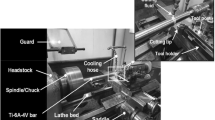Abstract
The grinding process is characterized by a large number of undefined cutting edges that are simultaneously in contact with the workpiece to achieve a fine surface finish and a high geometrical accuracy. To enable an efficient grinding process, the application of cutting fluids is an indispensable factor. This investigation shows that—depending on the cutting fluid composition—the fluid has varying influence on the achieved technological results and on the energy consumption of the process. Therefore, it is important to identify a cutting fluid which balances technological, environmental and economic requirements. Against this background, this paper investigates the technological influence of different cutting fluids regarding the achieved surface roughness and consumed energy. On the basis of experimental data, regression models are derived and used to evaluate the environmental and economic impact. As significant extension of the state of research equation-based models for the relationship of cutting fluids and energy demand as well as quantitative indications of saving potentials are provided.
Similar content being viewed by others
References
Klocke F (2009) Manufacturing processes 2—grinding, honing, lapping. Springer-Verlag Berlin Heidelberg, Germany
Winter M, Li W, Kara S, Herrmann C (2014) Determining optimal process parameters to increase the eco-efficiency of grinding processes. J Clean Prod 66:644–654
Gosalia A (2012) Sustainability … and the global lubricant industry. The 16th ICIS world base oils & lubricants conference, London, UK
Dettmer T (2006) Nichtwassermischbare Kühlschmierstoffe auf Basis nachwachsender Rohstoffe. Dr.-Ing. Dissertation, TU Braunschweig, Vulkan Verlag, Essen, Germany (in German)
Hipler F, Gil Girol S, Fischer RA, Wäll C (2000) Chemie gegen Reibung und Verschleiß: Untersuchung molekularer Wirkungsmechanismen von Thiadiazol-Schmierstoffadditiven. Mater Werkst 31:872–877 (in German)
Bartz WJ (1994) Additive für Schmierstoffe. Expert-Verlag, Renningen-Malsheim (in German)
Möller UJ, Nassar J (2002) Schmierstoffe im Betrieb. Springer Verlag GmbH, Berlin, (in German)
Herrmann C, Zein A (2010) Polymer water as optimal cutting fluid—technological analysis. The 43rd CIRP international conference on manufacturing systems, Vienna, Austria, pp 236–243
Winter M, Bock R, Herrmann C (2013) Investigation of a new polymer-water based cutting fluid to substitute mineral oil based fluids in grinding processes. CIRP J Manuf Sci Technol 6(4):254–262
Winter M, Bock R, Herrmann C, Stache H, Wichmann H, Bahadir M (2012) Technological evaluation of a novel glycerol based biocide-free metalworking fluid. J Clean Prod 35:176–182
Wichmann H, Stache H, Schmidt C, Winter M, Bock R, Herrmann C, Bahadir M (2013) Ecological and economic evaluation of a novel glycerol based biocide-free metalworking fluid. J Clean Prod 43:12–19
Wichmann H, Bahadir M (2007) Bio-based ester oils for use as lubricants in metal working. Clean Soil Air Water 35(1):49–51
Lawal SA, Choudhury IA, Nukman Y (2012) Application of vegetable oil-based metalworking fluids in machining ferrous metals—a review. Int J Mach Tools Manuf 52(1):1–12
Beck T (2002) Kühlschmierstoffeinsatz beim Schleifen mit CBN. Dr.-Ing. Dissertation, RWTH Aachen. Shaker Verlag, Aachen, Germany (in German)
Langemeyer A (2002) Entwicklung und Bewertung von kühlschmierstofffreien Schleifsystemen beim Flachprofilschleifen. Dr.-Ing. Dissertation, Technische Universität Braunschweig. Vulkan-Verlag, Essen, Germany, (in German)
Rabiey M (2010) Dry Grinding with cBN wheels—the effect of structuring. Dr.-Ing. Dissertation, Universität Stuttgart. Jost-Jetter Verlag, Hildesheim, Germany
Li W, Winter M, Kara S, Herrmann C (2012) Eco-efficiency of manufacturing processes: a grinding case. CIRP Ann Manuf Technol 61(1):59–62
Tönshoff HK, Peters J, Insaki I, Paul T (1992) Modelling and simulation of grinding processes. CIRP Ann Manuf Technol 41(2):677–688
Brinksmeier E, Aurich JC, Govekar E, Heinzel C, Hoffmeister H-W, Peters J, Rentsch R, Stephenson DJ, Uhlmann E, Weinert K, Wittmann M (2006) Advances in modeling and simulation of grinding processes. CIRP Ann Manuf Technol 55(2):667–696
Gutowski T, Dahmus J, Thiriez A (2006) Electrical energy requirements for manufacturing processes. The 13th CIRP international conference on life cycle engineering. Leuven, Belgium, pp 623–627
Kara S, Li W (2011) Unit process energy consumption models for manufacturing processes. CIRP Ann Manuf Technol 60(1):37–40
Li W (2012) Energy and eco-efficiency of manufacturing processes. Ph.D Thesis, The University of New South Wales, Sydney, Australia
Malkin S, Guo C (2008) Grinding technology: theory and applications of machining with abrasives. Industrial Press, Inc, New York
Vits R (1985) Technologische Aspekte der Kühlschmierung beim Schleifen. Dr. Ing. Dissertation, RWTH Aachen. Aachen, Germany (in German)
Marinescu ID, Rowe WB, Dimitrov B, Inasaki I (2004) Tribology of abrasive machining processes. William Andrew Publishing, Norwich
Malmodin J, Lundén D, Moberg Å, Andersson G, Nilsson M (2014) Life cycle assessment of ICT. Carbon footprint and operational electricity use from the operator, national, and subscriber perspective in Sweden. J Ind Ecol. doi:10.1111/jiec.12145
Ecoinvent Centre (2010) Database ecoinvent data v2.2. Centre for Life Cycle Inventories, Dübendorf
Zein A, Öhlschläger G, Herrmann C (2011) Polymer water as optimal cutting fluid: analysis of environmental advantages. The 44th CIRP Conference on Manufacturing Systems. Madison, USA
Winter M, Öhlschläger G, Dettmer T, Ibbotson S, Kara S, Herrmann C (2012) Using Jatropha oil based metalworking fluids in machining processes: a functional and ecological life cycle evaluation. Leveraging technology for a sustainable world, proceedings of the 19th CIRP conference on life cycle engineering. University of California at Berkeley, Berkeley, pp 311–316
Author information
Authors and Affiliations
Corresponding author
Rights and permissions
About this article
Cite this article
Winter, M., Thiede, S. & Herrmann, C. Influence of the cutting fluid on process energy demand and surface roughness in grinding—a technological, environmental and economic examination. Int J Adv Manuf Technol 77, 2005–2017 (2015). https://doi.org/10.1007/s00170-014-6557-1
Received:
Accepted:
Published:
Issue Date:
DOI: https://doi.org/10.1007/s00170-014-6557-1




